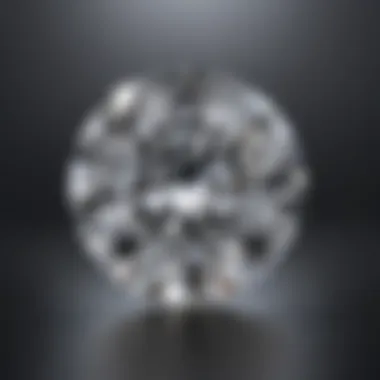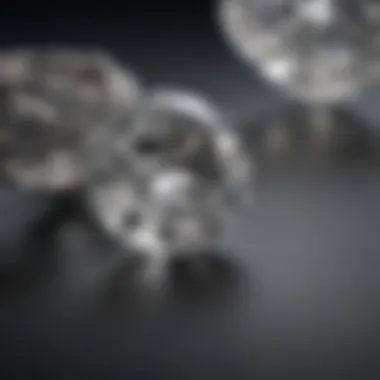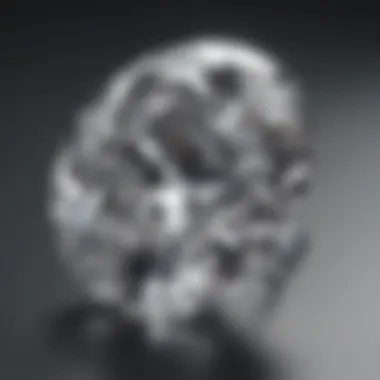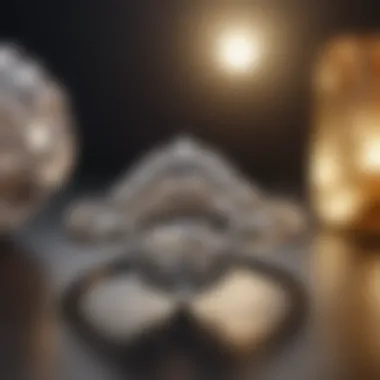Understanding Solitaire Diamonds: Significance and Characteristics


Intro
Solitaire diamonds hold a distinguished place in the realm of gemstones. With their singular beauty and deep cultural significance, they have captured the interest of collectors, jewelry designers, and enthusiasts alike. This article aims to elucidate the many facets of solitaire diamonds, focusing on their definition, significance, structural qualities, and the contexts in which they thrive. Understanding these elements is essential for anyone looking to appreciate, buy, or sell these valuable stones.
Gemstone Overview
Description of the gemstone
A solitaire diamond is characterized by its unique presentation—set alone in a piece of jewelry, often to emphasize its brilliance. These diamonds are usually cut to maximize their reflectivity and fire, showcasing their inherent beauty without the distraction of accompanying stones. Their solitary nature often symbolizes commitment, making them especially popular for engagement rings.
Physical properties
Solitaire diamonds are primarily composed of carbon atoms arranged in a crystal structure known as a diamond lattice. This structure contributes to their notable properties:
- Hardness: Diamonds rate a perfect 10 on the Mohs scale, making them the hardest known natural material.
- Light Refraction: The refractive index of diamonds ranges between 2.41 to 2.45, allowing them to display remarkable brilliance.
- Clarity and Color: High-quality diamonds are typically colorless or nearly colorless, with fewer inclusions contributing to clearer stones.
The appeal of a solitaire diamond lies not only in its aesthetic charm but also in these intrinsic physical properties that ensure its lasting beauty.
Significance in Jewelry Design
Solitaire diamonds are often the centerpiece of many fine jewelry pieces, most notably engagement rings. Their singularity lends them a timeless quality, making them suitable for both modern and traditional designs. The choice of a solitaire diamond signifies a deep emotional connection and personal commitment, making it a significant aspect of jewelry in various cultures.
Healing Properties
While primarily treasured for their aesthetic and symbolic attributes, some also attribute metaphysical properties to diamonds. Although not scientifically proven, these beliefs can enhance the appeal of solitaire diamonds for those interested in holistic practices.
Metaphysical attributes
- Clarity of Thought: Diamonds are thought to clear negative energy and promote clarity in decision-making.
- Strength and Resilience: They are believed to impart strength and courage, enhancing one's resolve.
- Emotional Healing: Some practitioners claim that diamonds can help alleviate emotional stress and foster positive energies.
Common uses in holistic practices
In holistic practices, diamonds are used in various forms, such as:
- Jewelry: Worn to promote emotional balance and clear negativity.
- Meditation: Used as tools during meditation sessions to enhance focus and spiritual connection.
- Energy Work: Incorporated in energy healing modalities to amplify the practitioner’s intentions.
Given these healing properties, solitaire diamonds appeal not only as gemstones but also as symbols of emotional and spiritual significance.
"A solitaire diamond isn’t merely a gemstone; it’s a profound emblem of love, commitment, and clarity—valued for both its beauty and its powerful symbolism."
Understanding solitaire diamonds requires a look into their significance, not just in a material sense but also in personal and cultural contexts. This duality enriches their status in jewelry design and emotional meaning.
Prelims to Solitaire Diamonds
The world of gemstones offers a rich tapestry of beauty and complexity. Among these wonders, solitaire diamonds stand out due to their unique charm and significance. This section explains the importance of understanding solitaire diamonds for both enthusiasts and collectors. It provides insights into their definition, the historical backdrop that shaped their allure, and their structural characteristics.
Understanding these elements is crucial for several reasons. For one, it helps individuals make informed choices when selecting a diamond. Solitaire diamonds often symbolize commitment, making them popular for engagement rings and other meaningful pieces. Additionally, appreciating the historical context can enhance the value one places on these gems.
In exploring the essence of solitaire diamonds, one uncovers not only their physical properties but also the emotions tied to them. Whether for personal use or as an investment, recognizing their significance is the first step toward a gratifying experience in the realm of jewelry.


Defining Solitaire Diamonds
A solitaire diamond is defined as a single diamond set in a piece of jewelry, typically a ring. This style focuses attention on the stone itself, allowing its brilliance to shine. The simplicity of the setting often enhances the perceived size and clarity of the diamond, thus elevating its visual impact.
The cut, color, clarity, and carat weight are the key factors determining the quality of a solitaire diamond. Each stone possesses its unique specifications, which collectively contribute to its overall beauty and value.
Solitaire diamonds can come in various shapes, such as round, princess, or oval, each offering different aesthetics while maintaining the hallmark characteristic of standing alone in its setting. This emphasizes the diamond's inherent qualities, providing a timeless elegance that many look for in fine jewelry.
Historical Context of Solitaire Diamonds
The allure of solitaire diamonds is deeply rooted in history. Originally, diamonds were believed to possess mystical powers, leading to their use in royal crowns and religious artifacts. Over time, the popularity of diamonds spread across cultures, becoming symbols of status and wealth.
The modern conception of solitaire diamonds took shape in Europe during the 18th century. Jewelers began to highlight the diamond alone in a setting, eschewing additional stones. This change aimed to showcase the diamond's brilliance and unique properties. The practice of using solitaire diamonds in engagement rings gained immense popularity in the late 19th and early 20th centuries, particularly with the advent of the De Beers marketing campaigns in the 20th century, which popularized the notion of diamond engagement rings as a must-have in romantic proposals.
Today, solitaire diamonds embody both luxury and emotional significance. They continue to be central to many personal milestones, acting as a bridge between history and modern practices in jewelry design. This understanding of their historical context not only enriches one’s knowledge but also enhances the appreciation of these stones.
Structural Characteristics of Solitaire Diamonds
Understanding the structural characteristics of solitaire diamonds is crucial for anyone interested in the world of gemstones. These features—cut, color, clarity, and carat weight—directly impact a diamond's beauty and value. In essence, the structure of a solitaire diamond informs not just its aesthetic appeal, but also how it will perform in various settings and how it is perceived in the broader jewelry market.
Cut and Shape
The cut of a diamond is a foundational aspect that dictates how light interacts with it, significantly influencing its brilliance and sparkle. The quality of the cut can make a clear diamond appear glimmering or dull. The popular shapes, such as round, princess, and emerald, each possess unique characteristics. For instance, round cuts are renowned for their scintillation, while emerald cuts emphasize clarity due to their larger facets.
Beyond the sparkle, the shape adds personality to the diamond. The choice between a classic round shape or a more modern princess cut can reflect individual tastes. The experience of selecting the best cut involves considering how it complements the wearer's lifestyle and style preferences.
Color and Clarity Standards
Color and clarity standards are essential in defining a diamond's quality. Diamonds are graded on a scale, where color ranges from colorless (D) to light yellow or brown (Z). A less colored diamond is often viewed as more desirable because it allows for better light reflection, leading to higher brilliance.
Clarity is assessed by the presence of inclusions and blemishes. The Gemological Institute of America utilizes a scale that categorizes clarity from Flawless (no inclusions visible under 10x magnification) to Included, which contains noticeable inclusions. Understanding these features helps buyers uncover both the visual and technical aspects of a diamond’s quality, drawing connections to its visual elegance.
Carat Weight Impact
Carat weight is another critical factor influencing a diamond's value. More significant carat weights generally command higher prices. However, weight is not the sole determiner of value. The combination of carat weight with the other characteristics, such as cut and clarity, creates a more holistic view of the diamond's worth.
It's essential to note that two diamonds of the same carat weight may differ drastically in value based on their cut, color, and clarity. Buyers should aim to find a balance that aligns with their preferences and budget. This understanding aids in making informed choices, ensuring that selections reflect both quality and personal taste.
Value and Significance
Understanding the value and significance of solitaire diamonds is crucial for both enthusiasts and collectors. Solitaire diamonds hold a unique position in the jewelry market. Their appeal transcends mere aesthetics, intertwining with cultural, emotional, and financial dimensions. Recognizing these aspects can greatly influence purchasing decisions, pricing strategies, and even the evaluation of these gems as collectible items.
Market Trends in Solitaire Diamonds
The market for solitaire diamonds has evolved significantly over the years. Recently, consumers have shown a preference for ethically sourced and lab-grown options. This shift reflects a broader trend towards sustainability and transparency in the gemstone industry. Additionally, younger generations prefer unique cuts and colors, moving away from traditional values of a perfect colorless diamond. This change also reinforces the resilience of the market despite economic fluctuations.
- Colorless diamonds continue to have strong demand, but fancy colors are gaining traction.
- Lab-grown diamonds are becoming a viable alternative, offering lower prices without compromising quality.
- Custom designs frequently fetch higher prices as they cater to individual tastes.
As trends shift, understanding the dynamics of the market is vital for making informed decisions.


Emotional and Cultural Importance
Solitaire diamonds are often seen as symbols of love and commitment, particularly in engagement rings. The emotional significance attached to these diamonds can not be overstated. Buying a solitaire diamond often marks a significant life event, imbued with personal meaning. Cultural customs and traditions further enhance this emotional connection. In many cultures, these diamonds are a rite of passage, representing not just financial commitment but also deep personal values and beliefs.
- Ritualistic values often accompany diamond purchases, linking them to marriage, anniversaries, and significant life milestones.
- Cultural symbolism varies across regions, influencing preferences for specific styles and characteristics such as size and shape.
Such emotional and cultural dimensions add layers of meaning that go beyond the gem itself.
Investment Value of Solitaire Diamonds
Investing in solitaire diamonds has become increasingly popular among collectors. They are often viewed as a hedge against inflation, much like real estate or stocks. The intrinsic value of these diamonds can appreciate over time, depending on several factors including rarity, quality, and market demand. However, potential buyers should approach this avenue with caution. Factors to consider include:
- Certification: Ensure the diamond is certified by reputable organizations such as the Gemological Institute of America (GIA).
- Market conditions: Understand current market trends before purchasing, as they can influence resale value.
- Rarity and quality: Unique features may increase a diamond's allure and potential appreciation.
The wise collector knows that true value lies in the combination of emotional significance and sound market knowledge.
By understanding the investment potential of solitaire diamonds, one can make informed and strategic decisions in their acquisition.
Practical Considerations for Purchasing
Buying a solitaire diamond is a significant investment. Understanding various practical considerations can influence the quality of your purchase. Awareness of these elements can lead to a more satisfying decision and a valuable addition to your collection. It is crucial to know what to look for in the buying process. This includes centering on where to buy, confirming authenticity, and employing effective pricing strategies.
Where to Buy Solitaire Diamonds
Selecting the right venue for your solitaire diamond purchase can impact the overall experience and value. Numerous options exist. Jewelers often present two main categories: online and brick-and-mortar stores.
Online Retailers offer convenience and often greater selections. Websites such as Blue Nile and James Allen provide detailed images and descriptions, allowing for informed decision making. However, ensure these retailers have good reviews and reputable certifications.
Local Jewelers might provide a personalized experience. They offer the opportunity to physically examine the solitaire diamonds and engage directly with experienced staff. Also, established jewelers can assist with future services, such as resizing or cleaning.
Always investigate the reputation of the seller. Look for certifications from recognized organizations like the Gemological Institute of America (GIA) or International Gemological Institute (IGI).
Verifying Authenticity
Next, verifying the authenticity of a solitaire diamond is essential in preventing fraud. When you purchase, ask for a grading report from a reliable gemological laboratory. A grading report should detail the cut, clarity, color, and carat weight of the diamond and assure you about its quality and authenticity.
Check for the following:
- Certification: Ensure the diamond has an official grading report from a recognized body.
- Laser Inscription: Some diamonds feature a laser inscription containing their certification number. This can be visible under magnification.
- Return Policy: Inquiry about return policies. If a seller is confident in their products, they will likely offer a reasonable return window. This allows you time to verify authenticity.
Pricing Strategies
Understanding pricing strategies can help you navigate the diamond market effectively. Prices vary widely based on multiple factors. Knowledge of these factors can ensure you make a fair purchase without overpaying.
- Understand the Four Cs: Familiarize yourself with the cut, color, clarity, and carat weight of diamonds. These factors significantly influence pricing.
- Research Market Trends: Monitoring current market trends can provide insight into pricing fluctuations. Knowledge about demand during seasonal peaks can guide your timing.
- Compare Prices: Always compare prices among various retailers before making a decision. This not only prepares you for negotiations, but also gives you a solid knowledge base.
"A well-researched buyer is often the most satisfied. Understanding where to purchase, ensuring authenticity, and knowing the pricing landscape can elevate your buying experience."
Care and Maintenance of Solitaire Diamonds


Caring for solitaire diamonds is essential to preserving their beauty and value. These exquisite gems require specific attention and maintenance to prevent damage and maintain their brilliance. Regular upkeep not only enhances their appearance, but it also extends the lifespan of the jewelry settings. Understanding the best practices in care and maintenance will contribute to a more rewarding experience for owners and collectors alike.
Regular Cleaning Techniques
Regular cleaning is vital for maintaining the sparkle of a solitaire diamond. Over time, dirt, oil, and debris can accumulate, dulling the stone’s surface. Here are some effective cleaning techniques:
- Gentle Soap Solution: Mix a few drops of dish soap with warm water. Soak your diamond jewelry for about 20 to 30 minutes. Use a soft brush, like a toothbrush, to gently scrub the diamond and its setting. Rinse thoroughly with clean water and dry it with a soft lint-free cloth.
- Ultrasonic Cleaners: For a deeper clean, ultrasonic jewelry cleaners can be used. This method uses sound waves to create tiny bubbles that dislodge dirt. However, ensure the diamond is secure in its setting, as some settings may loosen during the cleaning process.
- Professional Cleaning: Regular visits to a jeweler for professional cleaning and inspection can also be beneficial. Experts will ensure that the gemstone is properly cleaned without any risk of damage.
"Regular cleaning techniques play a crucial role in maintaining the visual appeal of solitaire diamonds."
Preventive Care Tips
Taking preventive measures can help avoid potential damage to solitaire diamonds. Here are some tips that can aid in this effort:
- Avoid Harsh Chemicals: Exposure to cleaning products or chemicals can damage the diamond or its setting. Always remove your diamond jewelry when using such substances.
- Store Properly: When not in use, store solitaire diamonds in a soft pouch or a separate compartment in a jewelry box. This practice prevents scratching and minimizes contact with other jewelry.
- Limit Physical Activities: Avoid wearing diamond jewelry during physical activities like sports or heavy lifting. The risk of impacting the stone is higher in such scenarios.
- Regular Inspections: Schedule regular inspections with a jeweler. They can check for any looseness in the setting and make necessary adjustments before any damage occurs.
By understanding and applying these care practices, solitaire diamond owners can ensure their investment retains its luster and significance for many years to come.
Solitaire Diamonds in Jewelry Design
Solitaire diamonds play a crucial role in the realm of jewelry design. Their unique characteristic of being set alone magnifies their beauty and elegance. This presentation of a single stone not only highlights its brilliance but also serves as a statement in both fashion and sentiment. Understanding the design elements and considerations behind solitaire diamonds can deepen appreciation for their aesthetic and emotional significance.
Popular Settings for Solitaire Diamonds
The setting of a solitaire diamond can significantly affect its overall appearance. A prong setting is the most common choice; it allows maximum light to enter the stone, enhancing its sparkle. Generally, three or four prongs are used, securing the diamond without obscuring it. Another popular choice is the bezel setting, which encircles the diamond with metal to provide added protection while giving a modern look.
In addition to prong and bezel settings, there are other styles worth noting:
- Tension Setting: Here, the diamond appears to float. The tension of the metal holds the stone in place. This contemporary style emphasizes the diamond's form even more.
- Channel Setting: This incorporates small diamonds alongside the central stone, adding brilliance while keeping a sleek profile.
- Pavé Setting: Small stones are set closely together, enhancing the sparkle around the main diamond.
Each setting has its advantages and can suit various personal tastes and styles. Choosing the right setting can enhance the diamond's unique qualities, making it not just a piece of jewelry but a personal emblem.
Custom Design Considerations
When it comes to customizing a solitaire diamond piece, several factors should be considered. One primary aspect is choosing the right shape and cut of the diamond. Round, princess, and oval are among the popular cuts, each offering a different visual feel. Consider personal style; some individuals prefer classic settings, while others may opt for a more avant-garde appearance.
Additionally, one must think about the metal type. Platinum, gold, and white gold each have unique properties and colors which can influence the overall aesthetic. Each metal can also affect care and maintenance needs.
A custom piece also entails understanding personal symbolism. Many people attach great meaning to the elements in their jewelry, including color, shape, and metal.
A carefully curated design not only showcases the solitaire diamond’s features but also imbues the piece with personal significance.
Epilogue
The conclusion section holds significant weight in this article. It brings together various insights and discusses the importance of solitaire diamonds in more than just aesthetic terms. This piece has highlighted several key facets, from the structural characteristics to their emotional value. By summarizing these points, we help readers understand why these diamonds hold considerable importance in the realm of jewelry.
Summarizing the Importance of Solitaire Diamonds
Solitaire diamonds embody not just beauty, but also a rich history and a blend of complex characteristics that contribute to their desirability. They are often seen as symbols of commitment and celebration. The unique features of each diamond, such as the cut, color, and clarity, play a crucial role in their value. Moreover, their historical context adds depth to their charm.
These diamonds are often the centerpiece in significant life events, such as engagements and anniversaries. Their singular representation signifies a deep emotional attachment, making them a preferred choice for many individuals. Recognizing this importance encourages appreciation not only for the diamonds themselves but also for the craftsmanship that goes into creating the jewelry that showcases them.
Encouragement for Informed Choices
In making informed choices regarding the purchase or appreciation of solitaire diamonds, it is vital to consider various factors. Firstly, understanding the specific characteristics of the diamond, including its grading and authenticity, helps in recognizing its worth. Shoppers should familiarize themselves with reputable sources, ensuring they engage with trustworthy dealers who offer verified stones.
Moreover, keeping abreast of current market trends can aid potential buyers in making wise decisions that align with their preferences and financial considerations. Ultimately, an informed choice enhances not only the satisfaction of acquiring one but also broadens one’s understanding of what makes each solitaire diamond unique. By empowering oneself with knowledge, buyers can navigate the intricate world of diamonds with confidence.







